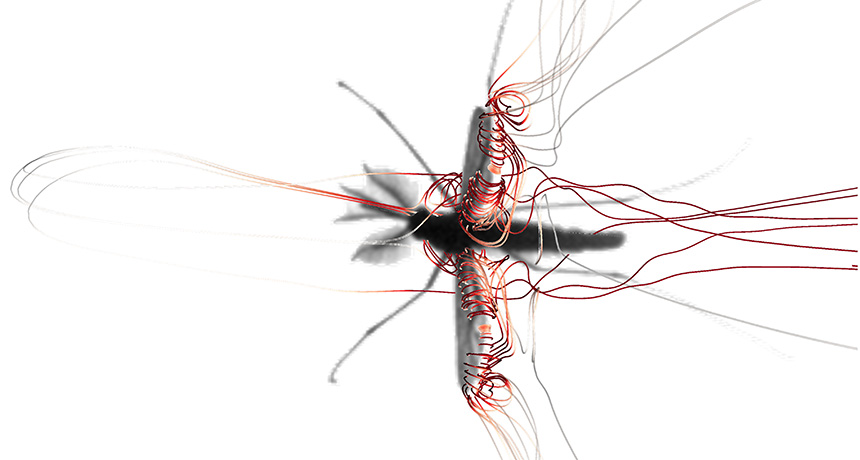Mosquito flight is unlike that of any other insect

Mosquitoes take weird insect flight to new heights.
The buzzing bloodsuckers flap their long wings in narrow strokes really, really fast — more than 800 times per second in males. That’s four times faster than similarly sized insects. “The incredibly high wingbeat frequency of mosquitoes is simply mind-boggling,” says David Lentink, who studies flight at Stanford University.
Mosquitoes mostly hover. Still, it takes a lot of oomph and some unorthodox techniques to fly that slowly. Mosquitoes manage to stay aloft thanks primarily to two novel ways to generate lift when they rotate their wings, Richard Bomphrey and colleagues write March 29 in Nature. The insects essentially recycle the energy from the wake of a preceding wing stroke and then tightly rotate their wings to remain in flight.
Most insects (and some birds and bats) rely on long wing strokes that create tiny low-pressure tornadoes called leading-edge vortices. The sharp front edge of the wing splits airflow in two, creating a bubble of swirling air along the front of the wing. Having low-pressure air above a wing and high-pressure air below generates lift.
But mosquitoes rapidly flap their wings up and down around a roughly 40-degree angle on average. Such short, speedy wingbeats make it impossible to generate enough lift from leading-edge vortices to stay in the air. “We knew something funny had to be going on. We just didn’t know what,” says Bomphrey, a biomechanist at the Royal Veterinary College of the University of London. So his team aimed eight high-speed cameras at hovering house mosquitoes (Culex quinquefasciatus) to model the physics of mosquito flight.
It turns out the insects flap their wings in a tight figure eight formation. Leading-edge vortices generate some lift as the wings briefly cut through the air horizontally. Then, as the wings start to rotate into the curve of the figure eight, they trap the wake of the previous stroke to create another series of low-pressure swirling vortices, this time along the back edge of the wing. “This doesn’t require any power. It’s a particularly economical way of generating lift,” says Bomphrey.
As the wings rotate, they also push air down, redirecting low-pressure air across the top of the wings. The wings rotate around an axis at their front edge, but if they go too far past vertical, they start to lose lift. So, the mosquito subtly shifts its wings’ turning axis from the front to the back of the wing, creating a more horizontal surface that allows the wings to continue to push air down. This also sets up the insect to benefit from the vortices along the trailing edge of the wing coming out of the turn.
Switching the axis mid-rotation “is impressive, especially since mosquito nerve cells fire just once for every few wingbeats,” says Itai Cohen, a Cornell University physicist not affiliated with the work. “Somehow this animal has evolved a complex wing stroke that takes advantage of aerodynamic forces and the mechanical infrastructure of the wing to generate complex motions with very few signals from the brain,” he says.
Bomphrey suspects that using these lift-driving forces may be common in mosquitoes and other insects that hover. But Lentink, who was not affiliated with the work, thinks it’s unlikely that lots of insects fly this way “because it seems so inefficient.”
Another force of nature may have driven mosquitoes to such illogical flight patterns: sex. Mosquito wingbeats make high-pitched tones, and males and females harmonize these tones in their search for a mate (SN: 01/31/09, p. 10). A flight style that entails fast flapping may have evolved as a result of sexual pressure to reach higher frequencies. That’s one theory anyway, and Cohen thinks it’s an interesting idea: “You’re talking about an insect sacrificing its flying capabilities in order to mate.”